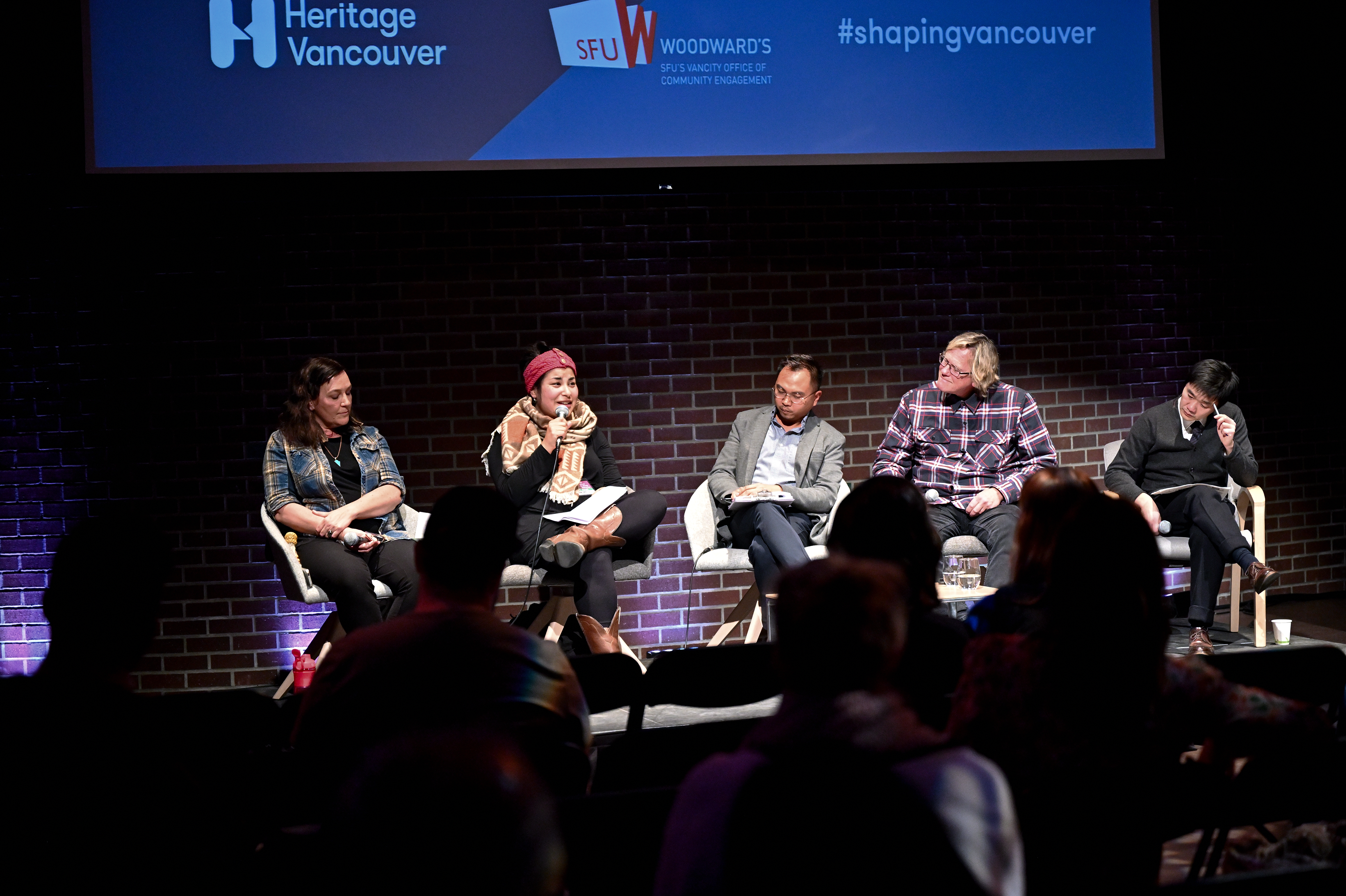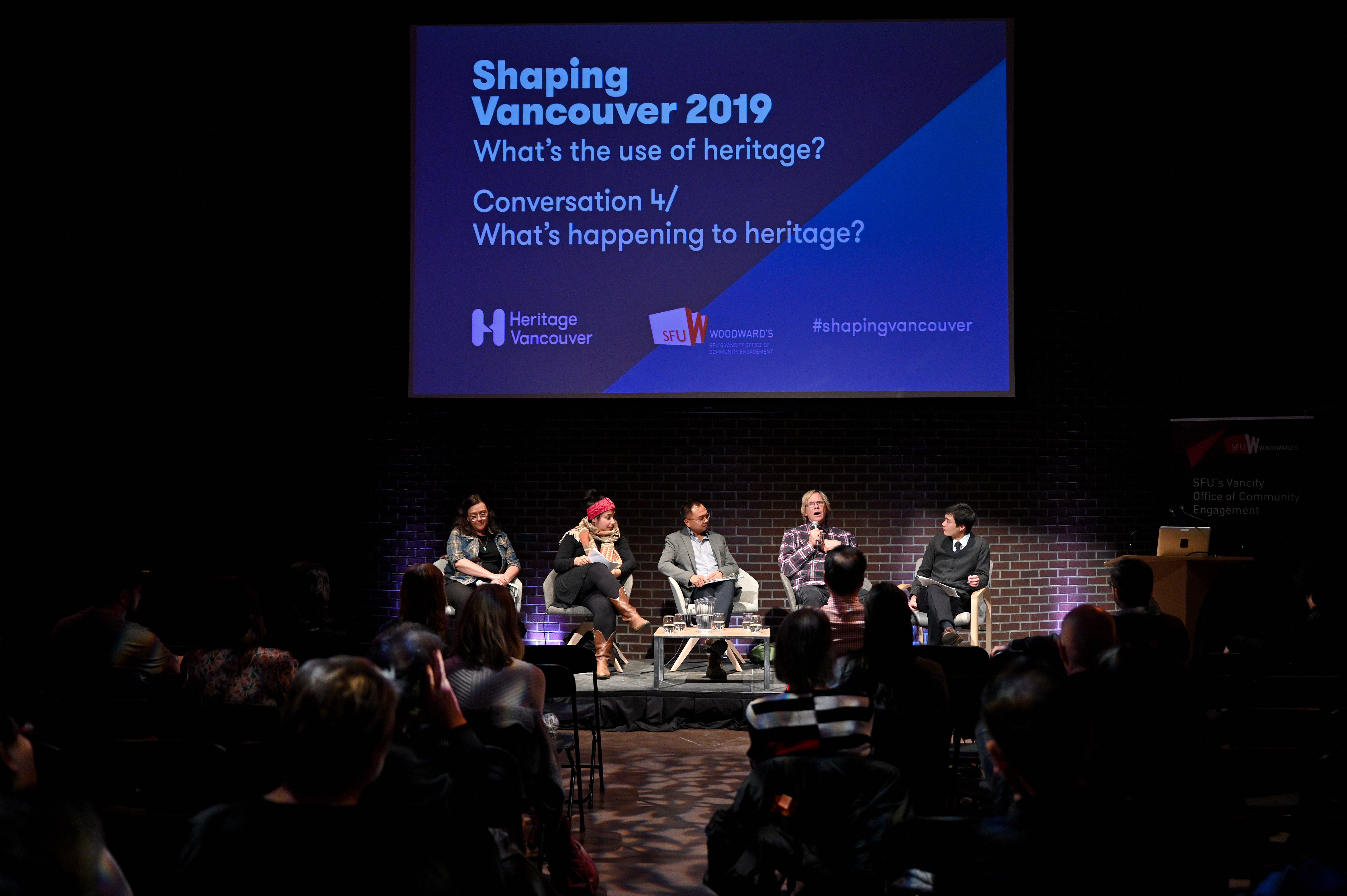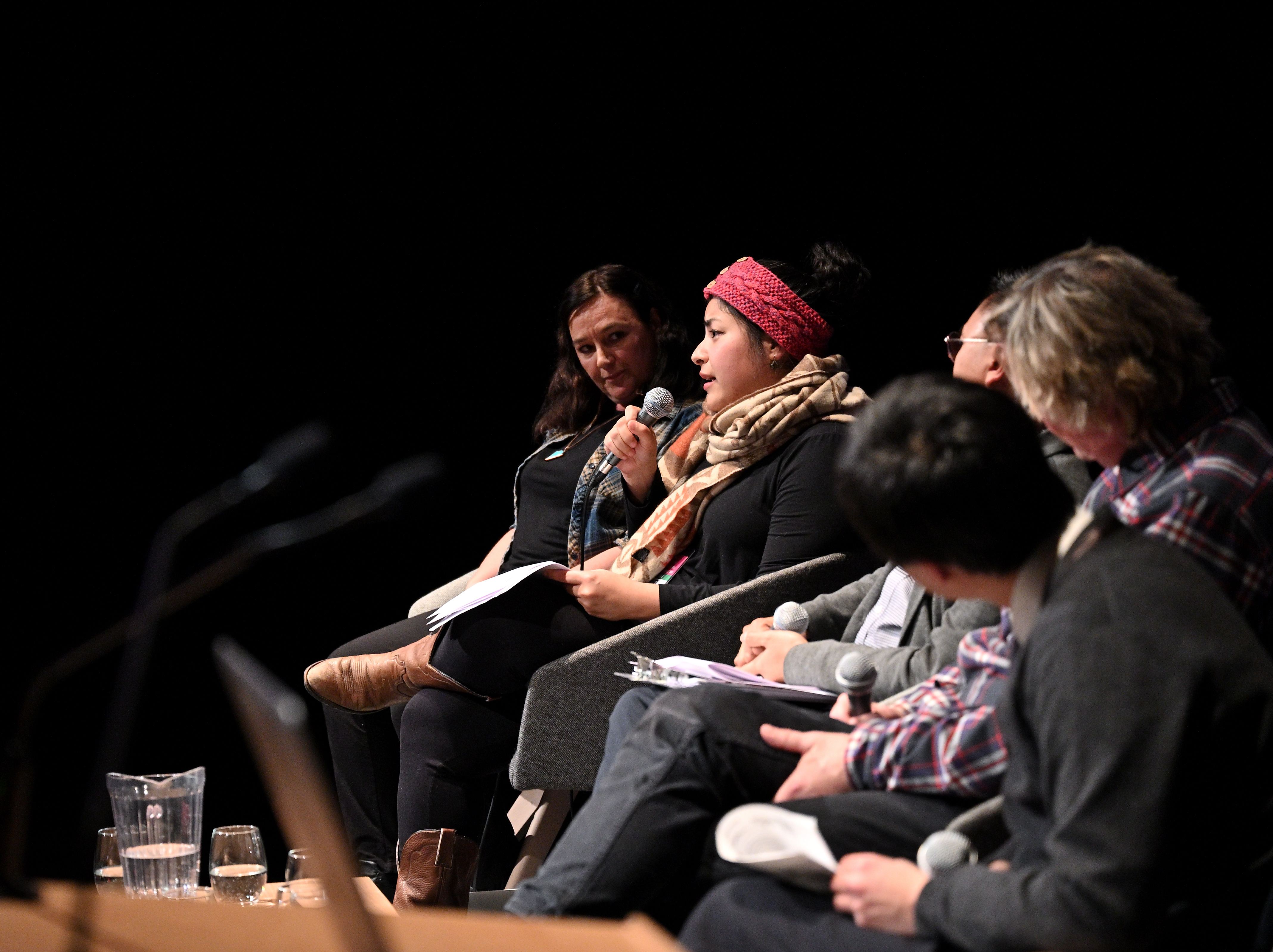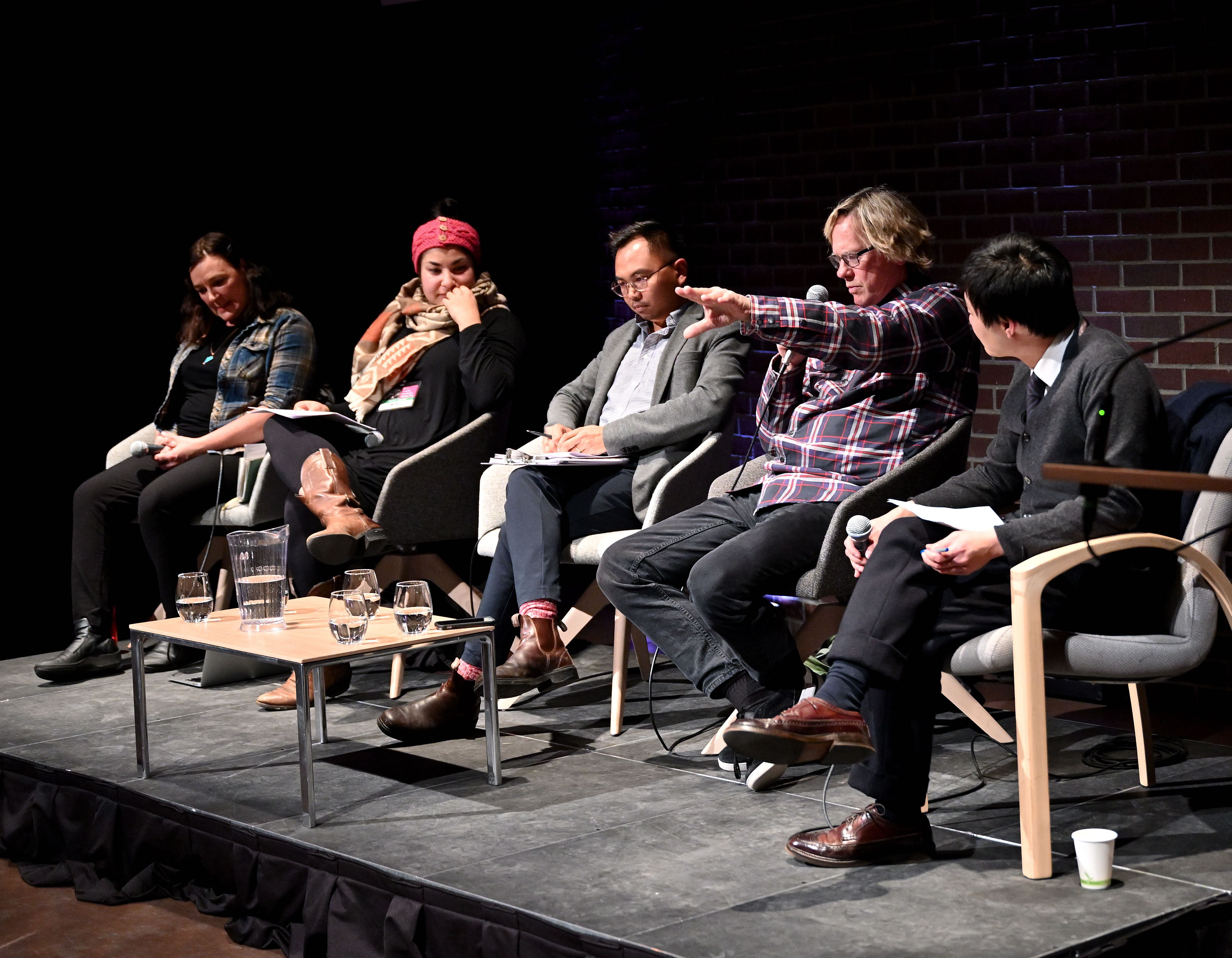Shaping Vancouver 2019: Conversation 4
What's Happening To Heritage?In this session of Shaping Vancouver, we discuss how heritage can be used to present multiple layers of stories across the city as well as the City of Vancouver’s Arts and Culture Plan’s approach to tangible and intangible heritage. Our final talk for 2019 looks at the opportunity for a new City-wide plan to carve out a larger role for heritage and integrate current heritage thinking into a wider range of the City’s social aims.

Moderator
Bill Yuen:
- Executive Director of the Heritage Vancouver Society
Panelists
Michael Gordon – Former Senior Downtown Planner, City of Vancouver, Vancouver Heritage Commissioner
Elijah Sabadlan – Heritage Consultant & Conservation Specialist
Carmel Tanaka – Founder, Cross Cultural Strathcona Walking Tour
Kamala Todd – Indigenous Arts and Culture Planner, City of Vancouver
When we think of our city as a whole, it is important that it sustains a strong sense of identity for the diversity of people who live here.
One important use of heritage would be to present the multiple layers of stories across the city so that we can experience the areas of Vancouver in a variety of ways.
The recent City of Vancouver Arts and Culture Plan proposes actions for the incorporation of new approaches to both intangible and tangible heritage. For the purposes of ongoing cultural vitality, redress and equity, it also proposes integration of intangible heritage into the City’s existing heritage program which up to now has mainly focused on the preservation of buildings.
This idea is consistent with best practices in heritage where it is not a standalone silo but approached as a part of culture, integrated into city planning for the purposes of economic, social and environmental sustainability.
Our final talk for 2019 will look at the opportunity for how a new City-wide plan might carve out a larger role for heritage and integrate current heritage thinking into a wide range of the City’s social aims.
Panelists
Michael Gordon – A year ago, City Council appointed Michael to the Vancouver Heritage Commission. Until 2018, he was Senior Downtown Planner for the City of Vancouver primarily focused on planning in the downtown peninsula and the West End. He has been an Adjunct Professor teaching Housing and Community Planning Policy at the University of British Columbia for 18 years. He was elected President of the Canadian Institute of Planners in 2013 and previously served as the Vice-President of the Planning Institute of BC. He has presented and written extensively on urban history, design, planning, music policy, skateboarding, demographics and housing. Currently, he is is shooting a documentary on the history of live music venues in Vancouver with Mark Pickersgill. He has been invited to speak and advise on urban issues in Berlin, New York, Seattle, Philadelphia, Portland, Memphis, Atlanta, Fort Worth, Toronto, Montreal, Vancouver, Halifax, Los Angeles and other cities. He has also received a number of awards for achievements in planning and his volunteer contributions to the planning profession and community-based planning.
Elijah Sabadlan – Elijah views heritage architecture as palimpsest in the continuing evolution of urban environments. As a Heritage Consultant with Donald Luxton & Associates, he provides heritage design and technical advice to the project team, from planning to construction. Recent projects include the preservation of the Old Stock Exchange Building Heritage Elevator Lobby, conservation planning for the Vancouver Post Office, and establishing a Conservation Guidelines for the Sinclair Centre. Other notable past conservation projects elsewhere include: the Broadview Hotel (Toronto, ON); the Imperial Oil Building lobby and Deer Park United Church (Toronto, ON); One Spadina Crescent (Toronto, ON); and Cultural Background Report for Port Union (Trinity Bay North, NL).
As an active member of the Canadian Association of Heritage Professionals (CAHP-ACECP) and its BC Chapter (BCAHP), Elijah uses his knowledge and expertise to build capacity and to facilitate conversations on conservation.e
Carmel Tanaka – Carmel Tanaka was born and raised in Vancouver, Canada on the unceded territory of the Musqueam, Squamish and Tsleil-Waututh people to an Israeli mother and a Japanese Canadian father. She holds a Master’s Degree in Emergency and Disaster Management from Tel Aviv University. Her specialties are organizational disaster management, partnership building and community development with experience in Australia, Canada, and Israel. Carmel’s pro-diversity stance and open door policy stem from valuing both sides of her heritage, which she describes as “Jewpanese”. This base provides Carmel with the ability to sensitively manage and effectively mediate challenging projects involving multi-generational intersectional groups with mixed political, religious and social opinions. She has founded and leads: the Cross Cultural Strathcona Walking Tour, Genocide Prevention BC, and JQT Vancouver (Jewish Queer Trans*).
Kamala Todd – Kamala Todd is a Metis-Cree mother, community planner, filmmaker, curator, and educator born and raised in the beautiful lands of the hən̓q̓əmin̓əm̓ and Skwxwú7mesh-speaking people, aka Vancouver. She has a Masters degree in Geography (UBC) and is the City of Vancouver’s first Indigenous Arts and Culture Planner. Kamala’s film credits include Indigenous Plant Diva, Cedar and Bamboo, RELAW: Living Indigenous Laws, and Sharing our Stories: the Vancouver Dialogues Project. She is the author of “This Many-storied Land”, in In This Together: Fifteen Stories of Truth and Reconciliation (2016), and Truth-Telling: Indigenous perspectives on working with Municipal Governments (2017) for Vancouver Park Board.
Introductions
Moderator Bill Yuen opened the discussion by talking about how the citywide plan has given us an opportunity to “think about heritage on a citywide level, and about all our stories that make up the city” as well as “what can we do to celebrate, learn from, and protect the places and practices we value for these stories”.


The panelists each started off by giving a brief description of what they do and what they care about in the field.
Michael Gordon began by talking about his personal and family history. He talked about being 14 years old and trying to figure out what he wanted to do when he came across a book called Fighting Back, which was about the Trippen Park community in Toronto fighting back against proposed demolition. It inspired him to pursue a career in heritage and eventually found himself in Regina, where he lived and worked in a diverse neighbourhood, before becoming a city planner in Vancouver. He is interested in public life and is “very interested now in the history of restaurants and food”, as public life is important when thinking “in terms of densifying and growing in this city.” In terms of Indigenous values, he “sees reconciliation as a journey, as a conversation”; for him, “it’s not binary” as “a lot of stories need to be shared” and lots of listening needs to happen.
Elijah Sabadlan introduced himself as a Filipino-Canadian and talked about his experience as a young immigrant assimilating to Canadian culture. He sees Vancouver as “a palimpsest of cultural heritage values, tangible and intangible, grounded first and foremost by the unique and diverse Indigenous cultural heritage.” Professionally, he works as a heritage consultant with Donald Luxton and Associates and spends most of his time “coordinating with a project team involving built heritage structures during various stages of the conservation process.” He wanted to take this talk as an opportunity to reflect on heritage conservation policies, methodologies, and practices and find ways to make it more inclusive and meaningful.
Carmel Tanaka, introduced herself as a half-Jewish, half-Japanese (Jew-panese) Vancouverite who leads the Cross-Cultural Strathcona Walking Tour. Much of her work is influenced by her identity as the descendant of Holocaust and Japanese internment survivors. She described it as “community, cultural, social justice, human-rights driven work that led me to the world of heritage”. She sees heritage as a “bridge through which I could bring different communities together to address important issues like racism, displacement, dispossession and discuss other issues” such as urban renewal.
Kamala Todd described herself as a half Metís/Cree and half first generation Canadian of Eastern European descent who grew up in Vancouver. Being raised in Marpole, she fostered a sense of connection to the city but always felt disconnected from her Indigenous roots and began to realize that she was “surrounded by a colonial narrative” full of erasure of Indigenous history and locations. Through her work in heritage, she seeks to address practices of reconciliation and how we hold these difficult discussions and how we are “actually reckoning with the history”. Currently, she is the Indigenous Arts and Culture Planner with the City of Vancouver, a job which enables her to “work with colleagues who are driving this change and who recognize the need for these conversations”.
Moderated panel discussion
Michael and I were talking in the back and he actually mentioned the maps of the three nations. Can you just kind of talk about that a little bit? (24:08)
Michael opened by talking about how the three nations in the Vancouver area have three different histories and stories, none of which are well-documented. He would like to see the nations be able to tell their own history. He brought up an example of an urban planning course he teaches at UBC where he takes his students on a walk around First Avenue and Burrard, which are Squamish Nation lands; now, there’s the Molson brewery, an armoury, and a fifteen-story high rise near the water. On the original Bartholomew Plan, the whole area was labelled as “Indian reserve park”, as the plan was used as a tool of colonization. Michael uses this walk and maps as a lens through which to see the “forces that benefited from taking the territory” and chiseling away at the land.
Carmel shared her experience in leading tours and the challenge in finding Indigenous voices to speak on the tours and share their experiences. She especially reflected on the importance of having Indigenous voices on the tours, not just restating history. She said that there was valuable feedback from participants which reinforced the need to have Indigenous history on the tour alongside narratives of Jewish and Japanese pasts.
Finally, Kamala opened her statement about the importance of Indigenous history by discussing the Indigenous systems in place before colonization as well as the individual sovereignty of Indigenous people and communities. She stated that Indigenous people “are sovereign people, with their own traditions, their own legal orders” and pointed to a quote in a policy report by the First Peoples’ Cultural Council which states: “the idea that to tell your history is a human right”. To her, a large part of reconciliation is “to have a voice and have control over telling the stories of these lands” as it is part of the larger conversation of Indigenous self-determination.

So this is also true for Indigenous peoples, that their heritage is traditionally not included. This is like many other groups, such as workers or women, or LGBTQ groups or certain people from different countries and cultures. Elijah and Kamala, you’re working in this. Are you seeing changes on this front? And, Michael, is this conversation being more inclusive of these other cultures and groups? (34:12)
Michael answered first and emphasized Vancouver’s unique diversity, especially compared to 33 years ago when the first heritage list was put together. Back then, there weren’t considerations of who put the list together and whose stories were being told. Presently, Michael said, we are still working with that list and are “hopeful we can get beyond that list” since he believes that’s where heritage should go in the future.
Elijah answered the question through his lens of conservation and the three steps of understanding, planning, and intervening. With the first two, he believes that there are a lot of changes happening now “in terms of going into a values-based approach”, which talks about sustainability, equity, diversity, and reconciliation. However, intervention is a knottier topic because the issue of the climate crisis is added in. He referenced a statement by the former president of the American Institute of Architects which stated that the most environmentally friendly buildings are the ones that are already built, thus advocating for the retention of old buildings. However, in changing old buildings (regardless of their heritage status), Elijah believes it goes back to understanding and planning these heritage resources because when you are talking about conservation, as we all can hear from our voices, there are many different perspectives ”. Elijah saw positives in the City’s culture plan, Cultural Infrastructure Plan and City-wide plan because we start to talk about how buildings serve communities and not just as objects.
Carmel talked about the LGBTQ aspect of Bill’s question and the overwhelmingly positive response she got when asking members of the LGBTQ community to speak on her tours. However, she said that, despite the proliferation of tours in the city, “our communities are working in silos and there’s very little bridge-building”. Her efforts in bringing different communities together resulted in a “crazy long Excel sheet” of topics such as music, activism, resilience, etc. where they “could talk forever and ever” but decided to focus on education as a “safe” topic for the pilot project.
Lastly, Kamala raised the question of who gets to decide who has power to decide what is important if we have a shared history and a multicultural society. She recounted experiences where people dismissed Indigenous peoples saying that “the people who were here were a small number, insignificant hunter-gatherers”, who “were basically obstacles”. She pointed out that some of the places that are celebrated are traumatic to others but those who suffered are not given the same level of voice. In order to approach redress and justice, the issue of who has power to decide “what does and doesn’t have value” needs to be addressed.
Bill asked the other moderators to comment on Kamala’s statement about how to work in the directions which Kamala had just outlined. (47:52)
Carmel brought up an example of a Chinese/Japanese restaurant which, during WWII, was turned into an office for the internment of Japanese-Canadians. She sees sharing stories and trauma as an avenue for moving towards reconciliation.
Elijah built upon both comments by connecting the idea of bad memories and associations to the LGBTQ community. He talked about his experience in high school in a conflict resolution group where they were taught “how to unlearn our biases and how to look at someone else’s perspective” and establish commonality “when dealing with these heavy topics”. For Elijah, interpersonal relationships are key to getting to know another culture or community – “only then that we can actually have those cultural shifts in thinking”.
Finally, Michael shared his story as an out-of-the-closet gay youth in the 1970’s and a story he read about somebody who bullied him being implicated in pushing a man of Pakistani descent in front of a subway train. As a result, he was pulled out of school and had to go for counseling, even until today. For him, that was an informative experience in realizing he has something in common with people of color. His experience in early-70’s Toronto and connecting the dots between racism and homophobia led him to empathize and understand new narratives; to realize the importance of conversations and how trauma can shape one’s life and experiences.


When we work in heritage, there’s a big focus on the building as an object, but we don’t really focus so much on the meaning of the building. Do you think that happens? Usually when it comes up, it’s the building that is under threat usually. Can you discuss that? (55:36)
Carmel started by bringing up an example from a previous tour she led which passed by a produce store in Chinatown which had burned down. The importance wasn’t in the loss of the produce but the “loss of yet another cultural space that really meant a lot to people in Chinatown”. For the community, an emotional bond with the building was more important than the content, a sentiment mirrored in many places as older buildings are replaced with condominiums or other structures. For Carmel, built heritage serves its purpose and helps to facilitate the “stories of intersection” which she aims to tell. The tantamount importance of buildings is “to be able to see them, smell them, touch them, be in them, but also have people who are storytellers and experts” to be on hand to “help when there isn’t the building.” She also talked about the challenges of working with limited or non-existent budgets and the importance of volunteers. In trying to tell stories like she is, finances are just one of the many challenges. There are crises of conscience when working as small, community organizations which Carmel described the challenges of having to work with.
Focusing on the idea of traumatic spaces, Kamala talked about a mental health facility in New Westminster that was the centre of debate. When planning for the Woodlands facility was being done, patients who had experienced abuse there called for the building to be torn down. For them, having it “still exist was physically painful”. This example points to the tension between built environments and the potentially traumatizing or harmful stories they hold. She connected the Woodlands example back to how land can hold trauma and the erasure that Indigenous peoples endured. Kamala said that being able to interpret these histories in “different ways is extremely crucial” and talking about them together prevents a vacuum where one interpretation is made default.

For the last question, Bill asked the panelists to talk about the City-Wide Plan and its effects on heritage. What should the system be – maybe not building-based but more landscape-based? (1:06:18)
Michael opened by talking about an experience he had as a city planner, an offshore high rise developer wanting the gay bars to go, and the reduction in building height and removal of residential-use areas in the Davie Village area. The instance was not the only of its kind and stressed the tension between being swamped by foreign wealth and the needs and wants of local people. Michael sees that as a strong argument for the exigent need for a citywide plan.
Elijah built on Michael’s discussion of the tension between newness and heritage by talking about the change in the heritage register from being materials-based to values-based. However, it is only an incremental change because architecture and architectural value still elevate a heritage resource. One of the shifts he would like to see, through the lens of built heritage, is a shift from focusing on the economic potential of heritage and tourism to more place-making opportunities in communities. In that sense, it doesn’t matter if a building is on the heritage register because it turns into a resource that people can mould and adapt to their needs, and where people can discuss things such as trauma. The conversation shifts from being object-based to a living heritage approach.
Kamala talked about Culture|Shift and its idea of “blanketing the city in arts and culture” centering “around reconciliation, decolonization, redress, equity, and access”. The dominant way in which heritage is approached and city planning is conducted has tended to excluded different communities. One example Culture|Shift is looking to change this is to support the MST Nations in telling their stories of Vancouver. From the ground up, this fundamentally shifts our understanding of a place’s cultural heritage or what should be protected. She ended by saying how hopeful she is that this is moving in the right direction.
Carmel ended the panel discussion with three points: development doesn’t necessarily take into consideration the potential of space to create culture, the necessity of having an open invitation to all communities to invite them to decide and identify how best to contribute (which might look different from community to community), and the importance of flipping the status quo definition of heritage.
We acknowledge the financial assistance of the Province of British Columbia. Thank you to SFU’s Vancity Office of Community Engagement for co-presenting the series.
All photo credits go to roaming-the-planet.